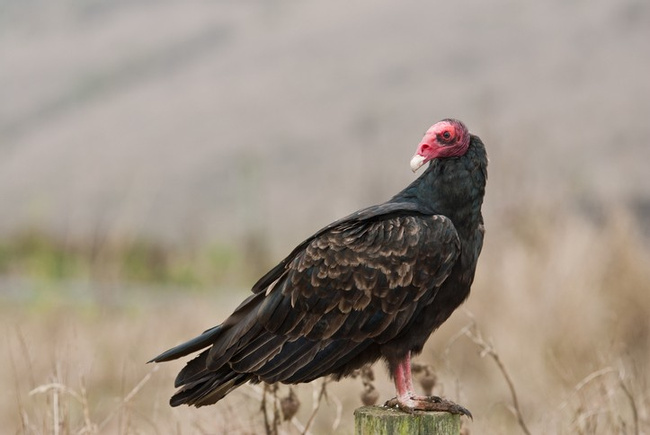Turkey Vulture
King of the scavenger, the turkey vulture (Cathartes aura) is one of the most common large carnivorous birds in North and South America. These birds have a keen sense of smell that allows them to hone in on (and eventually devour) the decaying flesh of animals. In fact, the word vulture comes from the Latin word vellere, which means to tear or pluck.

More about Turkey Vulture
Habitat
Turkey vultures are often seen in open areas like fields, rangeland and roads, but they roost in trees and cliffs at night.
They are found year-round in South America, Central America, Mexico and parts of the southeastern United States. During the summer (when they are breeding) they are found in southern Canada and throughout the entire United States.
Turkey vultures that breed in the U.S. and Canada fly south during the winter, often passing through Panama en route to their destination. Between 2010 and 2011, some 548,700 turkey vultures were counted from the Cerro Ancón watch point in Panama City.
Physical Description
Turkey vultures are large birds with dark feathers and long wings. They have long “fingers” at the tips of their wings and long tails. The birds are dark brown and have a featherless red head. While soaring, turkey vultures keep their wings raised, which appears as a “V” when seen from the front.
Interesting Biology
Turkey vultures have a sharp sense of smell that allows them to find dead animals. In comparison to other birds, turkey vultures have a much larger portion of their brain responsible for processing smell—they can detect a few parts per trillion. This allows them to easily locate dead animals.
Turkey vultures also have an impressive immune system—this allows them to eat dead animals (and their associated bacteria) without getting sick.
The bird’s slow but teetering style of flying allows it to soar at low altitudes where it can sniff out dead animals. They do, however, also use thermals to fly high. While on the ground, they move by hopping.
Turkey vultures can form roosts that range from 10 to 100 individual birds during the non-breeding season. Migrating flocks can be as large as 1000.
The birds don’t build full nests. Rather, they will scrape out an area in soil or leaves for their nest. Interestingly, they may use these areas repeatedly (up to a decade) as nesting sites. They tend to build nests in caves, ledges, hollow logs, or even abandoned buildings.
The birds’ clutch size is typically 1–3 eggs. The eggs incubate for 28–40 days and the nest for another 60–85 days.
Turkey vultures are classified as Least Concern (LC) on the IUCN’s Red List of Threatened Species.
Diet
Turkey vultures are scavengers that eat carrion (the decaying flesh of dead animals). They mainly eat mammals but will also eat fish, reptiles, amphibians, and even other birds. Turkey vultures will not attack living prey. At carcasses, several birds may be present but usually only one will feed.
Height/Weight
These birds are approximately 25–32 inches (64–81 cm) long and have a wingspan of 67–70 inches (170–178 cm). Their average weight is 70.6 oz.
Brief Taxonomy
Order: Falconiformes
Family: Cathartidae
Sources
Kirk, D.A., and M.J. Mossmon. 1998. Turkey Vulture (Cathartes aura). The Birds of North America, No 339 (A. Poole and F. Gill, eds). The Birds of North America Online, Ithaca, New York.
Similar Profiles
It's more than just having a good time or visiting beautiful places (although that's absolutely a part of it!), it's about being part of a unique experience that stays with you.



